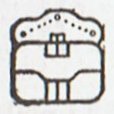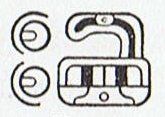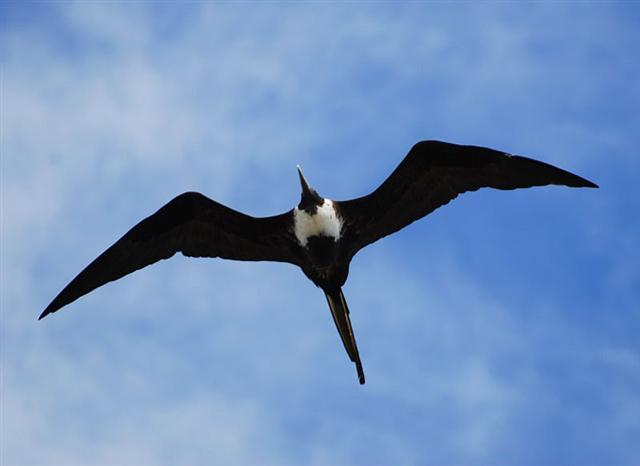|
TRANSLATIONS
|
The structure of the bird list needs to be changed:
|
pi riuriu |
sooty tern |
kukuru toua |
albatross ? |
ruru |
black petrel |
|
kava eoeo |
d:o |
makohe |
frigate |
taiko |
|
te verovero |
d:o |
kena |
booby |
kumara |
white tern |
|
ka araara |
d:o |
tavake |
redtailed tropic bird |
kiakia |
|
tuvi |
gray tern |
|
tuao |
dark brown tern |
|
tavi |
small lead-coloured tern |
If these 15 bird items should represent the cycle of
Sun, we can for instance count with 24 days for each bird
because 24 * 15 = 360. The last 3 birds would then cover 3 * 24 = 72
days (equal to the page number where the birds are located in
Manuscript E).
On the other 'hand', with 20 days for each bird, which is suggested
by the text in Manuscript E and
which agrees with the Mayan structure, there will be 4 * 20 =
80 days for each group in the table above, and 20 * 15 = 300
(presumably the Sun year according to counting time by the
Moon).
Beyond kiakia there will then be 3 * 20 = 60
days, just as from the exit of Sun at 16 Pax:
 |
 |
 |
 |
|
16 Pax |
17
Kayab |
18 Cumhu |
19 Vayeb |
The small lead-coloured tern named tavi
certainly represents Saturn (with very poor light). But the Mayan calendar
evidently has
18 * 20 + 5 = 365 regular days, not 15 * 20 = 300. This
difference can be eliminated if we add 3 months from the 'back
side' of the previous year, and we can then update the bird
table anew:
|
4 pi riuriu |
sooty tern |
8 kukuru toua |
albatross ? |
12 ruru |
black petrel |
|
5 kava eoeo |
d:o |
9 makohe |
frigate |
13 taiko |
|
6 te verovero |
d:o |
10 kena |
booby |
14 kumara |
white tern |
|
7 ka araara |
d:o |
11 tavake |
redtailed tropic bird |
15 kiakia |
|
16 tuvi |
gray tern |
|
17 tuao |
dark brown tern |
|
18 tavi |
small lead-coloured tern |
|
|
72) |
|
he
manu tara.erua kauatu te huru.i too mai ai |
|
20 |
he pi
riuriu |
a
Teke. a Oti |
|
20 |
he
kava eoeo |
a
Teke. a Oti |
|
20 |
he
te
verovero |
a
Teke. a Oti |
|
20 |
he
ka
araara |
a
Teke. a Oti |
|
20 |
he
kukuru toua |
a
Teke. a Oti |
|
20 |
he
makohe |
a
Teke. a Oti |
|
20 |
he
kena |
a
Teke. a Oti |
|
20 |
he
tavake |
a
Teke. a Oti |
|
20 |
he
ruru |
a
Teke. a Oti |
|
20 |
he
taiko |
a
Teke. a Oti |
|
20 |
he
kumara |
a
Teke. a Oti |
|
20 |
he
kiakia |
a
Teke. a Oti |
|
20 |
he
tuvi |
a
Teke. a Oti |
|
20 |
he
taiko |
a
Teke. a Oti |
|
20 |
he
tavi |
a
Teke. a Oti |
|
he ki
a Teke.kia Oti.ka mau tahi te kaha manu |
|
ena ki
runga ki te miro.he mau tahi e Oti. |
All these bird names begin with he. In addition te is
added at verovero and ka in the following araara
- which suggests teka (the 'fire stick'). The first 'bird
quarter' is completed with the pair verovero and araara.
Te signifies the presence of Sun according to
the kuhane list of place names, we should remember. And he
occurs only at Tama:
|
1 |
nga
kope ririva tutuu vai
a te
taanga |
|
2 |
te
pu mahore a hau maka o hiva |
3 |
te
poki uri a hau maka i hiva |
4 |
te
manavai
a hau
maka o hiva |
|
5 |
te
kioe uri a hau maka o hiva |
6 |
te
piringa aniva a hau maka o hiva |
7 |
te
pei a hau maka o hiva |
8 |
te
pou a hau maka o hiva |
|
9 |
hua reva a hau maka o hiva |
10 |
akahanga a hau maka o hiva |
11 |
hatinga
te
kohe a hau maka o hiva |
12 |
roto iri are a hau maka o hiva |
|
13 |
tama
he
ika kino
he
ihu roroa |
|
29 |
te
pito o
te
kainga a hau maka o hiva |
13
at Tama can be understood as the result of adding 1
('one more') to number 12:
|
1 |
2 |
3 |
4 |
5 |
6 |
|
He
Anakena |
Hora iti |
Hora nui |
Tagaroa uri |
Ko Ruti |
Ko Koró |
|
12 |
11 |
10 |
9 |
8 |
7 |
|
He
Maro |
Vaitu potu |
Vaitu nui |
Tarahao |
Tehetu'upú
|
Tua haro |
There are 3
double-months around winter solstice:
|
10 |
11 |
12 |
1 |
2 |
3 |
|
Vaitu
nui |
Vaitu
potu |
He
Maro |
He
Anakena |
Hora
iti |
Hora
nui |
While the
bird list offers only 2 double-months and presumably after summer solstice:
|
9 |
10 |
11 |
12 |
|
he
ruru |
he
taiko |
he
kumara |
he
kiakia |
|
|
ascending |
|
5 |
6 |
7 |
8 |
|
he pi
riuriu |
he
kava eoeo |
he
te
verovero |
he
ka
araara |
|
top |
|
9 |
10 |
11 |
12 |
|
he
kukuru toua |
he
makohe |
he
kena |
he
tavake |
|
descending |
|
13 |
14 |
15 |
16 |
|
he
ruru |
he
taiko |
he
kumara |
he
kiakia |
|
renewal |
|
17 |
18 |
19 |
|
he
tuvi |
he
taiko |
he
tavi |
Above I have added 4 to reach an ordered
structure with 17 at the beginning of the new cycle.
Beyond te-ka light has returned
in full strength. Colours can therefore be assigned to the
quartet of birds which follow.
Kena probably represents white, and tavake can
illustrate red by way of its beak and tail.
Makohe is the frigate bird, and we should notice that it
was Mako'e who who named the places in the 2nd list and who stayed alone on the island.

Maybe the frigate bird corresponds to black. The pattern with
a change from black to white was used from Te Pei
to Te Pou and also from Kumara to Kiakia.
The central colour change of the bird list is from makohe to
kena (from 10 to 11).
As
to
kukuru toua we need a separate page.
|
"The sea
bird named kukuru toua, which follows the sooty tern
sequence, has not been identified so far (Fuentes 1960:239). The
addition toua indicates the color of the egg yolk, while the
first word seems to indicate the Polyesian word for pigeon (MQS.
kuku; MAO., RAR., TUA., kukupa; TAH. 'u'upa; MGV.
kukuororangi; TON. kulukulu). In a recitation, the
following is said about this bird:
| ka riti te hupee |
How it flows from the nose when he cries |
| (paringi te matavai) |
(y derrama lágrimas) |
| o te kukuru toua |
of the yellow Kukuru |
| eve pepepepe |
with the very short tail. |
|
(Barthel 1960:854; addition by
Campbell 1971:404) |
The Metoro chants contain
two additional fragments:
| kua hupe ma te maitaki |
| kua rere te manu vae oho |
| ku pepepepe te manu kukurutou |
| ...... |
| eaha te huri |
| o te manu kukurutou |
| ko te manu eve pepepepe |
|
(Barthel 1958:177, 188) |
While the spelling
of the name is slightly different, in this instance too, the very short tail
(eve pepepepe) is mentioned. The bird in question might
conceivably be Diomedea melanophrys, an albatross with black lids, or
even Diomedea chlororhyncos, the yellow-beaked albatross. In this
case, kukuru toua would describe the peculiar shape of the
beak (compare the 'tubular noses' of petrels) and its yellow color, while
eve pepepepe seems to refer to the relatively short tail of the powerful
bird. If this identification is correct, then the albatross is ranked after
the sooty tern, who is the object of a cult, but ahead of the frigate bird;
and because of his size, the albatross precedes the following enumeration of
sea birds." (Barthel 2)
Here there is much to consider. Barthel's idea of the size of
the bird being significant is reasonable. A great (Herculean) 'fire' should be
represented by a good-sized bird. We remember the small lead-coloured
Saturn-bird tavi at the end of the list.
|
top |
|
he
kukuru toua |
he
makohe |
he
kena |
he
tavake |
|
descending |
|
he
ruru |
he
taiko |
he
kumara |
he
kiakia |
|
renewal |
|
he
tuvi |
he
taiko |
he
tavi |
The very short tail of this
great bird probably means it has a short life span. Maybe his
tail ends with the arrival of the black makohe,
and his spirit (pepe) will then leave.
|
Pepe
1. A sketch. 2. Bench, chair,
couch, seat, sofa, saddle; here pepe,
mau pepe, to saddle; noho pepe,
a tabouret. Pepepepe, bedstead. 3.
Pau.: butterfly. Ta.: pepe, id. Mq.:
pepe, id. Sa.: pepe, id. Ma.:
pepe, a moth; pepererau, fin,
Mgv.: pererau, wing. Ta.: pereraru,
id. Ma.: parirau, id. Churchill.
Sa.: pepe, a
butterfly, a moth, to flutter about.
Nukuoro, Fu., Niuē,
Uvea, Fotuna, Nuguria, Ta., Mq.:
pepe, a
butterfly. Ma.: pepe,
a grup, a moth; pepepepe,
a butterfly; pepeatua,
a species of butterfly. To.: bebe,
a butterfly. Vi.: mbèbè,
a butterfly. Rotumā: pep,
id. Churchill 2.
Mq.: Pepepepe, low,
flat. Ha.: pepepe, id. Churchill. |
If toua means yellow, then
his spirit should be a butter-fly. But I think
another interpretation is more to the point, viz.
the fertile land which has recovered from the season
of 'straw':
| Tou
In ancient times, a
tou was someone who had recovered
from an epidemic, but whose illness
meant that someone else in the family
had to die. The tou were regarded
as portents of evil. Toutou,
lush; fertile (land). Toûa: Egg
yolk; the colour yellow; soft, fibrous
part of tree bark; toûa mahute,
mahute fibres. Vanaga.
Toua: Wrath,
anger, rage, revenge, battle, combat,
debate, dispute, dissension, uprising,
revolt, quarrel, fight, hostility (taua);
toua rae, to provoke, rae toua,
to open hostilities, toua kakai,
to rebuke, tuki toua, to stir up
dissension; totoua, hostility;
hakatoua, fighter, warrior. P Mgv.:
toua, war, battle. Mq.: toua,
war, dispute, quarrel. The form with
o is found only in these three
languages, taua is found in the
general migration, Rapanui is the only
speech which has both. Toutou,
fertile (tautau); hakatoutou,
to fertilize. Mq.: taútaú,
fertile. Toùvae, to run;
hakauruuru toùvae, id.
Churchill. |
Expressed in glyphs the fully grown
warrior (hakatoua) probably is tagata:
The yellow Kukuru should be the personification of Spring Sun. When
he leaves abruptly after a short lifespan, there
will be tears. He will be struck by a fin like
Kuukuu, the planter.
...
No sooner had he pushed her up and lifted her
completely off the ground when she struck
Kuukuu with one fin. She struck downward and
broke Kuukuu's spine. The turtle got up,
went back into the (sea) water, and swam away.
All the kinsmen spoke to you (i.e. Kuukuu):
'Even you did not prevail against the turtle!'
His spine will snap like the sika
(= teka?) of Tu'i Tofua and the
'turtle' will then return to the sea.
The planetary time is Mercury and he is not visible
for more than a short while (he has a short tail).
Mercury is the young reckless driver of the solar
chariot who ends at the bottom of the sea (eve):
| Eve 1.
Placenta, afterbirth (eeve). T Pau.: eve, womb. Ta.:
eve, placenta. Ma.: ewe, id. Haw.: ewe, navel string.
2. The rear; taki eeve, the buttocks; hakahiti ki te eeve,
to show the buttocks; pupuhi eve, syringe. 3. The bottom of the
sea. Churchill. |
|
|